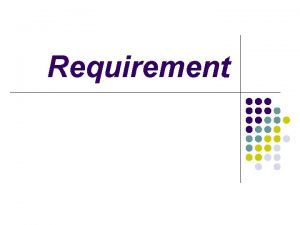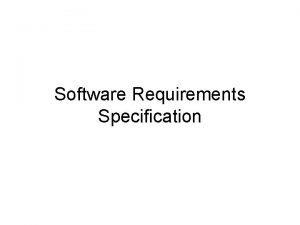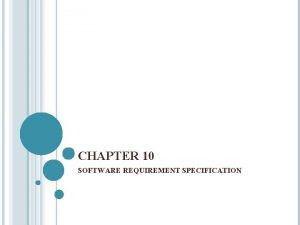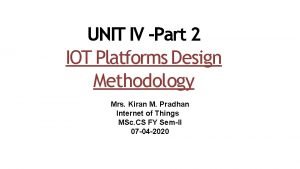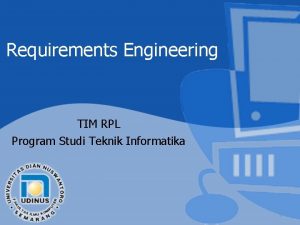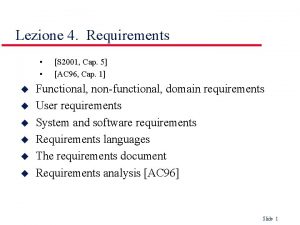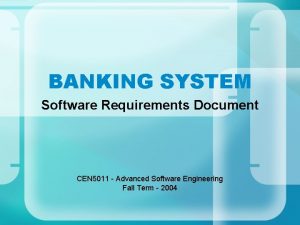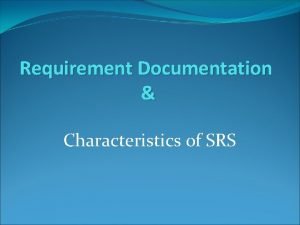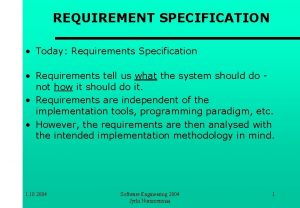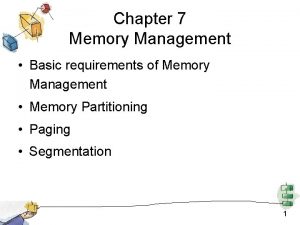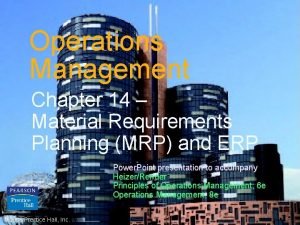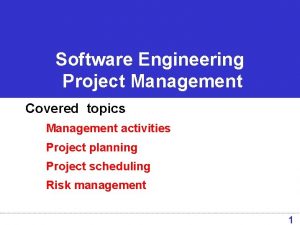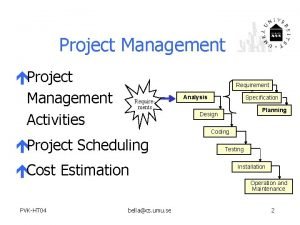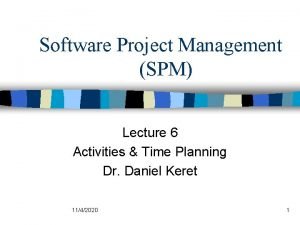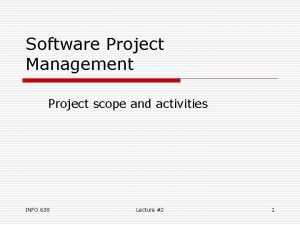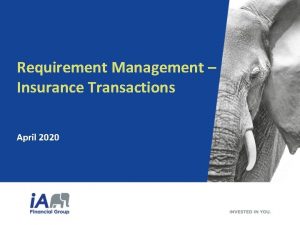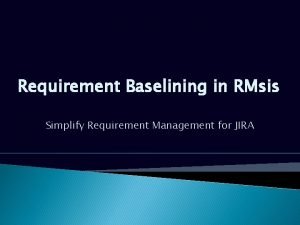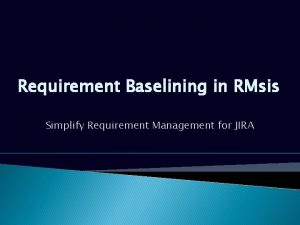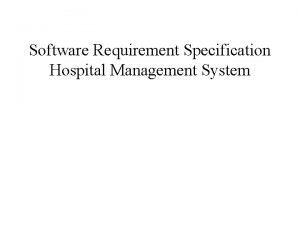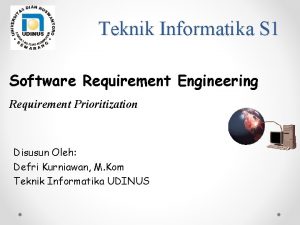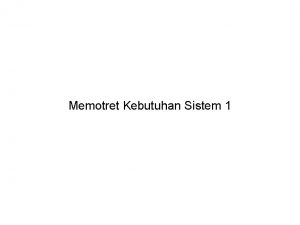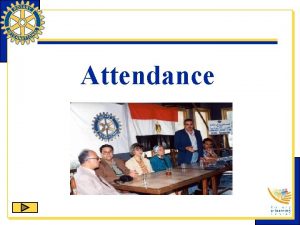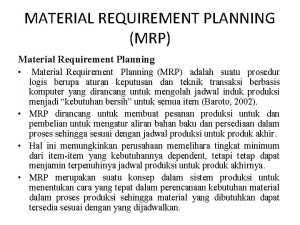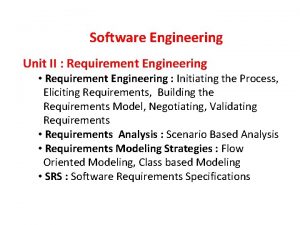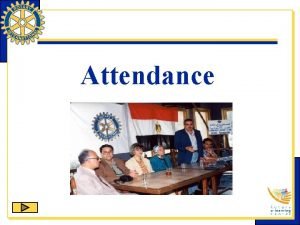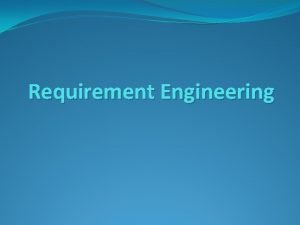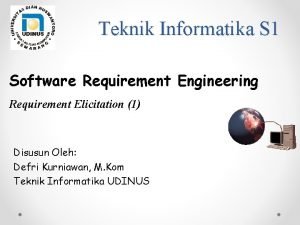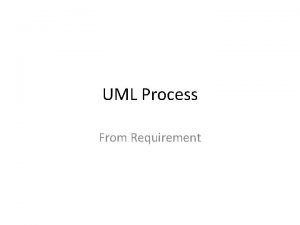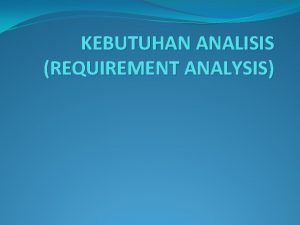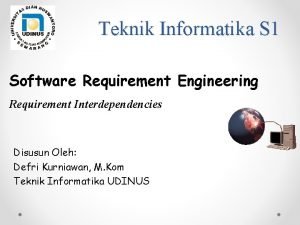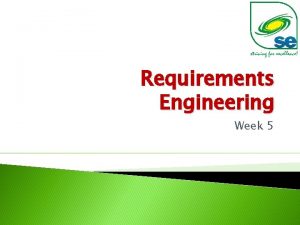Project Management Project Management Activities Requirement s Specification













![COCOMO Constructive Cost Modelling [Boehm 81] Based on publicly available historical data of 63 COCOMO Constructive Cost Modelling [Boehm 81] Based on publicly available historical data of 63](https://slidetodoc.com/presentation_image/55e347a6fed697668bedf6c33d0117eb/image-14.jpg)









- Slides: 23

Project Management éProject Management Activities Requirement s Specification Analysis Planning Design Coding éProject Scheduling éCost Estimation Testing Installation Operation and Maintenance PVK-HT 04 bella@cs. umu. se 2

Project Management Activities Project acquisition Project planning o Resource assessment o Risk and option analysis Cost estimation Project scheduling o Work breakdown structure o Effort distribution o Resource assignment Project tracking and control Reporting PVK-HT 04 bella@cs. umu. se 3

Project Resources People o o Required skills Availability Duration of tasks Start date Hardware and software tools o o Description Availability Duration of use Delivery date PVK-HT 04 bella@cs. umu. se 4

Risks and Option Analysis What is a risk? Compare different development alternatives Evaluate their risks Select best alternative Tools o o Polar graph Decision tree Forms. . . PVK-HT 04 bella@cs. umu. se 5

Top Ten Project Risks Staff deficiencies Unrealistic schedules and budgets Developing the wrong functions Developing the wrong interface Over-engineering Changing requirements Externally developed items Externally performed tasks Performance problems PVK-HT 04 bella@cs. umu. se Assumptions on technology 6

Define Work Breakdown Structure Activity o o o Major work unit Start date End date Consumes resources Results in work products (and milestones) Project o Continue throughout the project o Not bound to specific phases Step 1 Phase 1 PVK-HT 04 Project function Step 2 Step 1 Phase 2 Step 2 Phase N Activity 1 Activity 2 Activity 3 Activity 1 Activity 2 Task 1 Task 2 Task 3 Step 1 bella@cs. umu. se Step 2 7

Schedule Activities Almost all activities depend on the completion of some other activities Many activities can be performed in parallel Organisation necessary to balance work-load, costs, and duration o PERT chart (activity network/task graph) Critical path Project Time-line (Gantt chart) Resource table PVK-HT 04 bella@cs. umu. se 8

PERT Charts Program Evaluation and Review Technique Graph o Nodes = activities/tasks and estimated duration o Edges = dependencies Compute o Slack time = available time - estimated duration o Critical path A path is critical when it contains an activity that, if delayed, will cause a delay of the whole project. PVK-HT 04 bella@cs. umu. se 9

Example PERT Chart PVK-HT 04 bella@cs. umu. se 10

Gantt charts A Gantt chart is used to graphically present the start and end dates of each software engineering task o One axis shows time. o The other axis shows the activities that will be performed. o The black bars are the top-level tasks. o The white bars are subtasks o The diamonds are milestones: • Important deadline dates, at which specific events may occur PVK-HT 04 bella@cs. umu. se 11

A Gantt Chart (Project Time Line) PVK-HT 04 bella@cs. umu. se 12

Another Gantt Chart PVK-HT 04 bella@cs. umu. se 13

Cost Estimation Approach Problems: o Decompose problem o Check for experiences/ data on sub problems o Make qualified estimations o (Make at least two independent estimates) PVK-HT 04 o What are good measures? o Do the estimates affect the result? o Does the type of software affect the result? o Does the project environment affect the result? o. . . Use empirical and historical data Algorithmic cost modelling COCOMO (based on LOC) FP (based on function points) bella@cs. umu. se 14
![COCOMO Constructive Cost Modelling Boehm 81 Based on publicly available historical data of 63 COCOMO Constructive Cost Modelling [Boehm 81] Based on publicly available historical data of 63](https://slidetodoc.com/presentation_image/55e347a6fed697668bedf6c33d0117eb/image-14.jpg)
COCOMO Constructive Cost Modelling [Boehm 81] Based on publicly available historical data of 63 TRW projects Basic assumptions: o o Requirements change only slightly during the project There is good project management The historical data is representative Assigning more resources to the project does NOT result in linear decreasing development time PVK-HT 04 bella@cs. umu. se 15

Basic Model Effort = a (KDSI)b Schedule = c (Effort)d • KDSI = Kilo Delivered Source Instructions ( LOC - comments) • The a, b, c, and d factors vary depending on the type of project • Effort is measured in PM (Person Months = 152 h of work) • Schedule is the Development Time measured in Months a b c d Organic 2. 4 1. 05 2. 5 0. 38 Semi-detached 3. 0 1. 12 2. 5 0. 35 3. 6 1. 20 2. 5 0. 32 In-house IS, Development in a familiar environment Between OM- and EM projects Embedded Large and inexperienced teams, many constraints Boehm, Software Engineering Economics, Prentice-Hall, 1981. 16

COCOMO Summary Works quite well in practice Needs KLOC as input Problems: o Estimating KLOC in early project stages o Comparison of projects using different LOC counts o Outdated metrics base (70 s) Solutions: o Cross-check using an other estimation technique o Standardised LOC counts o Continuous model calibration COCOMO II is a recent new version PVK-HT 04 bella@cs. umu. se 17

COCOMO II Goal: To develop a software cost and schedule estimation model tuned to the life cycle practices of the 1990’s and 2000’s 3 Models o Application Composition: prototyping to resolve high-risk user interface issues, 2 environment drivers, 0 process drivers, Sizing in Object Points o Early Design Model: to explore alternative architectures and concepts, 7 environment drivers, 5 process drivers, Sizing in Function Points or SLOC o Post Architecture Model: development has begun, 17 environment drivers, 5 process drivers, Sizing in Function Points or SLOC PVK-HT 04 bella@cs. umu. se 18

Effort and schedule in COCOMO 2 Application Composition Model Effort = NOP/productivity q NOP = OP * [(100 -%reuse)/100] q Productivity = NOP/man-months, 5 productivity levels depending on the 2 environment drivers (table 3. 12 course book) æEnvironmentö (Process Scale Factors) ÷ ç = [ ] Effort ç Multipliers ÷ Size è ø Environment: product, platform, people, project factors Early Design and Postarchitecture Model Process: constraint, risk/architecture, team, maturity factors Schedule =(Multiplier) [Effort] PVK-HT 04 (Process Scale Factors ) bella@cs. umu. se 19

COCOMO II Model Stages 4 x 2 x Early Design (13 parameters) 1. 5 x Overestimated 1. 25 x Relative Size Range x 0. 8 x Post-Architecture (23 parameters) 0. 67 x 0. 5 x 0. 25 x Plans and Rqts. and Milestones Detail Design Spec. Product Design Spec. Rqts. Spec. Concept of Operation Feasibility PVK-HT 04 Phases Underestimated Applications Composition (3 parameters) Product Design bella@cs. umu. se Detail Design Accepted Software Devel. and Test 20

COCOMO II summary COCOMO II + allow for spiral model instead of waterfall model only + Size of project can be listed as object points, function points or source lines of code (SLOC) + The environmental multipliers are calculated from seventeen cost drivers better suited for today's methods - Calibration is difficult, but can improve accuracy by a factor of five PVK-HT 04 bella@cs. umu. se 21

Function Points Function Point Analysis (FPA) measures the size of a software product in terms of the functionality it delivers to the users. A. J. Albrecht 1979 o What the software must do from the user’s perspective o Irrespective of software construction Based on five function types: o o o PVK-HT 04 Inputs Outputs Inquiries Logic Files Interfaces bella@cs. umu. se 22

Project plan contents Project scope Project schedule Project team organization Technical description of system Project standards and procedures Quality assurance plan Configuration management plan PVK-HT 04 Documentation plan Data management plan Resource management plan Test plan Training plan Security plan Risk management plan Maintenance plan bella@cs. umu. se 23

Difficulties and Risks in Project Management Accurately estimating costs is a constant challenge It is very difficult to measure progress and meet deadlines It is difficult to deal with lack of human resources or technology needed to successfully run a project Communicating effectively in a large project is hard It is hard to obtain agreement and commitment from others PVK-HT 04 bella@cs. umu. se 24
 Contoh requirement
Contoh requirement Software requirements specification definition
Software requirements specification definition Requirements engineering process
Requirements engineering process Value of good srs in software engineering
Value of good srs in software engineering In domain model specification, resources are
In domain model specification, resources are Contoh user requirement specification
Contoh user requirement specification Domain requirements
Domain requirements Software requirement specification for banking system
Software requirement specification for banking system Characteristics of documentation
Characteristics of documentation Srs document
Srs document Software requirement analysis and specification
Software requirement analysis and specification Functional requirements tell us
Functional requirements tell us If lclp is negative number, we set the lclp = 0. why?
If lclp is negative number, we set the lclp = 0. why? Upper specification limit and lower specification limit
Upper specification limit and lower specification limit Operating activities vs investing activities
Operating activities vs investing activities Indoor and outdoor sports examples
Indoor and outdoor sports examples Support activities and primary activities
Support activities and primary activities Examples of primary activities
Examples of primary activities Memory management requirements
Memory management requirements Product structure tree example
Product structure tree example Software management activities
Software management activities Project management activities
Project management activities Activities in spm
Activities in spm Activities covered by software project management
Activities covered by software project management
